
Simple Prepositions
Simple prepositions are single-word prepositions that express relationships of time, place, direction, manner, or other relationships. They are the most basic and commonly used type of prepositions.
Here are some key points about simple prepositions:
Examples of Simple Prepositions: Some examples of simple prepositions include "in," "on," "at," "over," "under," "with," "by," "from," "to," "through," "about," "for," "during," "after," "before," and "since."
Usage: Simple prepositions are followed by a noun, pronoun, or noun phrase (object of the preposition) to indicate the relationship between the object and other elements in the sentence. They establish connections of location, time, direction, possession, manner, and more.
Location and Place: Simple prepositions such as "in," "on," and "at" are commonly used to indicate location or place.
For example:
"in the park,"
"on the table,"
"at the office."
Time: Simple prepositions are also used to indicate time relationships.
For example:
"during the party,"
"after the game,"
"before the meeting,"
"at noon."
Direction: Simple prepositions like "to," "from," "into," "out of," and "through" indicate movement or direction.
For example:
"go to the store,"
"come from work,"
"jump into the pool,"
"walk out of the room,"
"run through the forest."
Other Relationships: Simple prepositions can indicate relationships of manner, means, and more.
For example:
"with a smile,"
"by car,"
"from the book,"
"to help,"
"through hard work."
It's important to note that simple prepositions are typically short words, but they play a crucial role in expressing relationships and adding clarity to sentences. Understanding their usage and common examples will help you use them effectively in your writing and communication.









Comments: